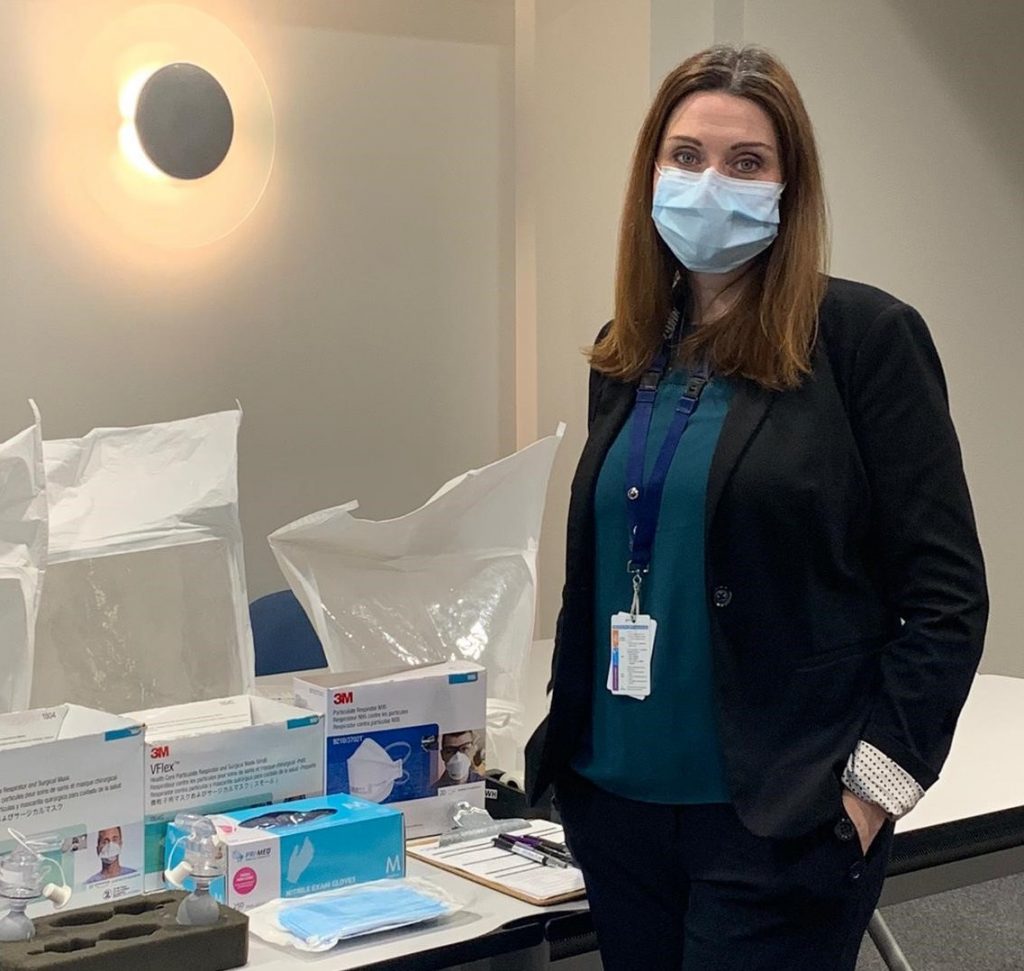
Q&A: Battling COVID-19 on the hospital’s front lines
January 21, 2021
By
OHS Canada
Melanie Gruneir discusses University Health Network's response

Melanie Gruneir, CRSP, is a workplace safety manager at Toronto Western Hospital, part of the University Health Network. (Photo submitted)
Since March 2020, organizations across Canada have been grappling with new health and safety protocols as a result of the COVID-19 pandemic.
Melanie Gruneir, CRSP, is a workplace safety manager at Toronto Western Hospital, part of the University Health Network (UHN).
Responses have been edited for length and clarity.
OHS Canada: How has the UHN adjusted its operations as a result of the pandemic?
Melanie Gruneir: Much like other health-care organizations, UHN’s operations have been and continue to be impacted by the COVID-19 pandemic. As Ontario went into lockdown during the first wave, the organization continued to provide the necessary care to our patients, but in a decreased capacity for some services.
The Incident Management System was launched to streamline the implementation of measures to support the safety of both patients and staff. Additionally, resources were allocated to support the procurement of necessary items such as patient care equipment and personal protective equipment (PPE).
In addition to providing care for our patients, the province asked UHN to manage a number of long-term care facilities. UHN staff volunteered to be redeployed to these long-term care facilities to help support the care of their residents.
Throughout the different waves of this pandemic, UHN has continued to be nimble and pivot as necessary, to ensure our patients come first, all the while ensuring that staff safety is not compromised.
OHS: What protocols have you implemented to protect staff and patients?
MG: UHN has implemented many protocols over the course of the pandemic to protect our staff and patients.
Infection, prevention and control measures have been developed for PPE use, the provision of safe patient care, and the prevention of the spread of COVID-19.
The respiratory protection program has been one area of focus for the UHN Safety Services – Workplace Safety team during the pandemic.
At the end of Jan. 2020, as it was unclear whether COVID-19 was spread via the airborne route, our team set up blitz N95 respirator fit testing to target staff who had not been fit tested in the past or who had invalid records, to ensure staff were protected.
Due to supply chain issues with certain types of N95 respirators, we have had to recall many staff to ensure that they have a valid fit test on a respirator that UHN has in good supply.
Our team has been involved in the review of a number of new N95/KN95 respirator brands to supplement our current models. As well, elastomeric half facepiece respiratory protection and powered air purifying respirators were trialed for use in different areas within the organization to help conserve UHN’s supply of disposable N95 respirators.
To ensure the safety of staff and our fit testing team, we adjusted our internal infection control protocols for the program.
Physical distancing measures were implemented and the use of a scheduling software began, to prevent staff from waiting in lines for their fit tests.
We updated the cleaning protocols for our fit test equipment and the PPE requirements for our fit testing team members.
OHS: As the pandemic continues, are there any areas of heightened concern for your employees?
MG: Throughout the pandemic, our staff have had concerns with regards to the risks of exposure to COVID-19 while on the front lines and the risk of bringing the virus home to their families.
Currently, as the community spread of the virus is increasing, we are seeing an increased number of staff members being exposed to or acquiring COVID-19. This is resulting in staffing pressures across the organization.
In addition, as the community cases rise, there are heightened concerns surrounding the increase in patient cases that we will see in the hospital environments and the system as a whole.
Plans have been developed to continue to ramp up capacity to provide care to COVID-19 patients. Staff and patient safety is a priority when developing and implementing these plans.
OHS: What health and safety lessons have you learned during this time?
MG: I have learned that the communication of risks and the safety measures being implemented to mitigate these risks is key to building trust and ensuring staff are informed of these safety measures to protect themselves and their patients.
UHN’s leadership team has made many efforts to ensure that staff are provided with timely information about safety measures, along with providing staff the opportunity to pose questions about issues that are of concern to them.
Additionally, I am reminded at how creativity can play an important role in the design and implementation of control measures for the protection of staff and patients. There has been a lot of innovation with respect to the protection of workers that has been sparked by this pandemic.